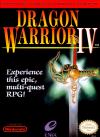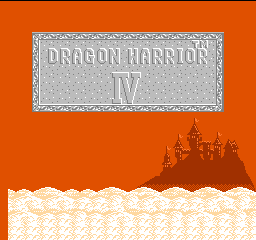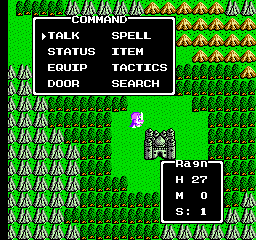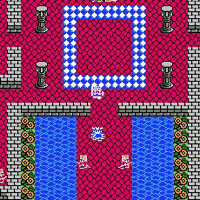While Squaresoft was already busy establishing its name as the reference in RPGs on the Super Nintendo with Final Fantasy IV, Enix was still hanging to the NES with its Dragon Warrior series. It’s a little sad, because Dragon Warrior IV was not only one of the most original games ever made, but also one of the most elaborates. Many gamers probably missed this masterpiece.
Graphics: 9/10
Being so late in the 8-bit era (released in 1992 in America), the graphics in DW IV are some of the best you can find on the NES. Sure, characters all have this weird coloring where their hair and armor have the same color. Nevertheless, the only game that showed more diversity for characters was Final Fantasy III, and even then you did not have to see all the different jobs (I never tried berserker or Viking).From the Hero/ Heroin (you choose the sex, which accounts for minor clothing differences) to Alena, from Cristo to Mara, all the characters are very easy to distinguish. Moving them around is still a little unresponsive (maybe it’s just the computer), but it flows better.
The world of DW IV is HUGE. There are more towns, more surface area to explore and you can now see the castles from the outside (rather than enter the “icon” as in Dragon Warrior III). The front reminded me a little of the Shining Force I castles; however I would say that the DW castle has much more to explore. The colors in the villages are also clearer and defined better, with even more things to explore with the small medals (more of that later). The dungeons are also very varied – no two are alike actually. Be it a cave or a tower, they all have different colors, patterns and tiling. Of course, you still get to see major differences between light and day; the transitions looks better.
Unfortunately, Enix barely made any efforts to improve the battles. It’s as static as the preceding three games, with enemies flashing when they attack/ get hit. The only major difference is magic, which shows some strategic color (red for fire spells, blue for ice, etc.), and the final boss battle, who goes through several stages. You can actually see his limbs disappear and re-appear and changing forms all through the battle.
Music: 9/10
While not my favorite soundtrack ever – I thought DW III had better arrangements – I nevertheless give it a 9 because of the sheer diversity of the soundtrack.
I don’t think I’ve played a game with so many overworld tracks. There are 6 in total: one for each of the first four chapters and two for the last one (you can even hear the previous chapters’ tracks by putting the right person in front). The complexity of the arrangements is also out-of-this-world. The Tower and Casino themes both loop after 90 seconds, something Uematsu achieved only in Final Fantasy V (Prelude to the Empty Sky). Although both themes suffer from 8-bit limitations (the Casino loops merely consists of a part repeated again and again), the Tower one had a very heavy and interesting synth comparable to early Genesis games like Sword of Vermilion – and DW did it MUCH better. Other good synthesized themes include the battle against Necrosaro and the final battle.
And even though they don’t loop for that long, other themes show their superiority to FF III. The arrangements for the dungeon theme are far more complex than the first such theme in FF III, the castle theme really sounds “regal” (and its orchestrated version sounds like a real minuet) and the battle theme integrates the “flashing” screen even better than DW III. And the boat theme sounds far more epic than in FF III, while the shrine theme was prolonged in an interesting way.
Sound effects, however, are pretty much the same. You still hear that annoying sound whenever you hit an obstacle, and battle sounds haven’t changed. Also, there isn’t as much variety for villages. It’s either a standard theme for towns of the castle theme. DW III did it better.
Addictiveness: 9/10
Concomitant with the game’s place in the 8-bit era, it has quite a lot to offer.
For me, the storyline was quite enough to get me hooked up (see below). The story unfolds progressively and in a mostly logical manner (there are some holes, like what happened to Alena’s people).
Otherwise, the sheer number of sidequests will certainly hook you up. There are some 40 small medals dispersed all over the world, all of which can give you access to rare and strong equipment like the Metal Babble Helm or the Sword of Miracles (restores health). There is also a huge casino that integrates classics (the monster arena) and presents new things like slots and poker. The latter one, when combined with savestates, will automatically make you a winner, making you buy the Metal Babble Shield in no time.
Story: 9/10
The story is divided in 5 chapters.
Chapter 1: You play Ragnar, a royal solider sent on a mission to look for missing children. Why are they disappearing?
Chapter 2: Alena, a tomboy princess, yearns for freedom. She escapes her castle and embarks on a journey that brings her to a fighting tournament, where a mysterious Necro is the king of fighters.
Chapter 3: Talon is an arms merchant who wants to own his own business. His desire for riches and fame leads him to finance a tunnel to have a better access to the other side of the sea.
Chapter 4: Mara and Nara are two sisters whose father got killed by an apprentice. They will seek revenge.
Chapter 5: The story starts with the hero/ heroin living in a remote, isolated village. He narrowly escapes death when Necrosaro invades the village to kill him. He then goes around the world and notices that people are looking for him. He will join forces with the heroes of the previous chapters in order to fin the Zenithia gear in order to conquer the ultimate evil.
This has to be one of the most original RPG scenarios ever. The story progresses in a slow, continuous manner and all the events in every chapter is related to one another. When Ragnar finds out where the children are, the villain he fights says that he wants to destroy the hero (in chapter 5) before he becomes too strong. Talon’s sponsorship of the tunnel construction will bring more monsters, etc.
Depth: 10/10
Not only is the story logical and continuous, it goes into deep. If you explore carefully each city during each of the first 4 chapters, you will see / hear about the other characters as they are looking for the legendary hero. And once you do control the hero/ heroin you will see what the other characters have done and other bits and pieces of the story (Talon’s tunnel, the princess of Endor’s wedding, the bridges that get repaired).
In addition, once you do gather all your characters, there is still a long way to go before you complete the game. You need to get the Zenithia gear, the hot-air balloon, get to Zenithia, go through the Dark World…
Difficulty: 7/10
This game is an RPG, so obviously you need to grind your levels in order to stand a chance against the monsters. It’s especially true in chapters 1 and 2, where the big fights happen with characters who don’t have magic spells. It may be easier for Ragnar if he finds Healie, but Alena will both need to have a high level (fortunately, there are metal babbles nearby) and have enough medical herbs so she can heal between fights. And in Chapter 5, getting by will be hard until you can get Mara and Nara (your magic is limited). Fortunately, savestates will help you fight the enemies you want, especially the King Metal, worth 30k experience each.
However, most of the difficult comes from the lack of control you have of your teammates. In the first 4 chapters, you will be able to temporarily recruit characters over whom you have no control. They might attack and help you or cast useless spells that won’t help you at all (and they can’t carry any items). In chapter 5, you will only have control over the hero’s actions. You can, at best, give general instructions (use no MP, normal) to your characters who will still act independently. So if you don’t want them to waste herbs and antidotes inside the fight, make sure they don’t own such objects. However, magic casters tend to cast useless spells (beat, sleep) over and over again.
Some dungeons also have complex puzzles (especially in the Dark World) or doors and passages that are hard to find due to Enix’ usual graphics limitations (you can’t see all the dungeon from above; you need to enter the actual room to see it). It may be realistic, but I find it tedious; even Final Fantasy I did it better.
But overall, Dragon Warrior IV is a game every RPG lover should play. It offers a very rich and deep storyline, the difficulty level can be dealt with thanks to a little thinking and the many sidequests will surely take up a lot of your time!


 User Notice
User Notice 







